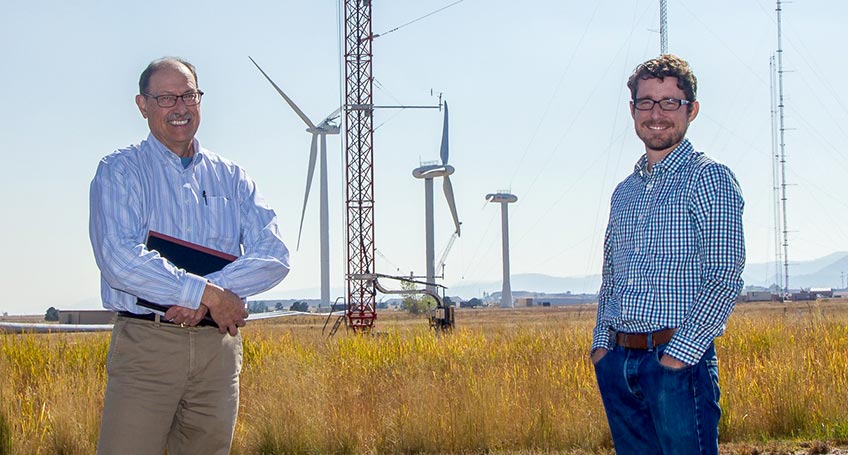The Leading Edge: November 2019 Wind Energy Newsletter
Floating wind innovations rise up in this edition of the Leading Edge, from an innovative platform system developed by NREL researchers to funding awards that will lead to advancements in floating offshore wind turbines.
News Stories
NREL Selected for Offshore Wind Turbine Research Projects
NREL has received $5.7 million in new funding from the U.S. Department of Energy's Advanced Research Projects Agency-Energy (ARPA-E) for work in the field of floating offshore wind turbines. NREL was named prime contractor for three projects within ARPA-E's Aerodynamic Turbines Lighter and Afloat with Nautical Technologies and Integrated Servo-control (ATLANTIS) program, which seeks to develop radically new floating offshore wind turbines. These projects include a partnership with the Colorado School of Mines and the University of Colorado Boulder, University of Virginia, University of Illinois Urbana-Champaign, and the American Bureau of Shipping to lower the cost of energy through the use of floating offshore windmills; a collaboration with the University of Illinois Urbana-Champaign to develop open-source software for floating wind turbines; and a joint effort with the University of Maine that will generate the first public data set to include advanced turbine and platform control.

SpiderFLOAT Spins a Web of Offshore Wind Innovation
Designed by NREL researchers, a new scalable offshore floating wind system dubbed "SpiderFLOAT" for the system's spider-like components could help drive down the cost of deep-water wind energy. SpiderFLOAT challenges the existing paradigm of offshore energy production—historically influenced by oil and gas project design—by drastically reconceptualizing what's possible for an offshore wind platform and spinning a web of new innovations to accompany the system. SpiderFLOAT is also getting funding through ARPA-E ATLANTIS.
Get To Know Wind Pioneer Paul Veers
An NREL biographical article on wind energy pioneer Paul Veers chronicles his professional journey from tending cows on a Wisconsin dairy farm to becoming a newly appointed NREL senior research fellow. Veers was the lead author of a recent Science article posing three challenges to wind energy becoming one of the world's primary sources of low-cost electricity generation. Veers emphasizes the opportunities for innovation and the need for worldwide collaboration on wind energy research in Energy News Network's interview, "NREL Engineer on the 'Grand Challenges' of Supersizing Wind Power on the Grid," including how wind energy research intersects with other renewable energy technologies like solar, battery storage systems, and electric vehicle technologies. You can read more about how NREL is integrating wind and grid in Utility Dive's article "Hanging with the Lab Rats: NREL Researchers Lay Groundwork to Accelerate U.S. Clean Energy Transition."

Downwind—In Case You Missed It
NREL Models Predict Lower Costs for Floating Offshore Wind
NREL's recently published "Oregon Offshore Wind Site Feasibility and Cost Study" indicates the cost of deploying floating offshore wind could be 30% to 40% less than previously estimated.
The study, funded by the Bureau of Ocean Energy Management, modeled the potential costs of floating offshore wind farms at least 10 nautical miles from Oregon's coast where wind speeds are some of the world's strongest. The levelized cost of energy (LCOE) for the hypothetical projects—600 megawatts each, outfitted with 15-megawatt turbines, and developed by 2032—ranged from $74 per megawatt-hour in the north to $53 per megawatt-hour in the south, near the California border.
The study builds off a similar NREL study published in 2016, which estimated the LCOE for floating offshore wind in California at $100 per megawatt-hour or less by 2030.
"The Oregon study reflects lower LCOE than the 2016 California study because of new cost and technology data that support lower capital and operational expenditures than were previously modeled," said Walt Musial, NREL's lead offshore wind researcher and one of the authors of both studies. "These results mean that the market for floating offshore wind is growing rapidly and verify the assumptions we've made about floating offshore wind costs decreasing. This should encourage developers that the technology is driving in the right direction."
Floating wind energy technologies will be required to tap Oregon's 62 gigawatts of available offshore wind energy resource—97% of which is in waters deeper than 60 meters.
Publications
Attitudes of U.S. Wind Turbine Neighbors: Analysis of a Nationwide Survey
As the energy market evolves to offer consumers more sustainable options, wind turbines will become an increasingly common sight in many communities. In the journal article from Energy Policy, "Attitudes of U.S. Wind Turbine Neighbors: Analysis of a Nationwide Survey," researchers present the findings of a cross-sectional survey of the attitudes held by wind project neighbors. These findings offer insight into the factors that influence social perceptions of wind projects—insights that can benefit policymakers and other leaders involved with wind project development.
IEA Wind Task 32: Best Practices for the Certification of Lidar-Assisted Control Applications
Lidar-assisted control, which provides preview measurements of wind speed and direction to the turbine's control system, is a promising technology for reducing a turbine’s structural loading, thereby decreasing stress on the turbine and optimizing the cost of energy produced by the turbine. In this conference series article, "IEA Wind Task 32: Best Practices for the Certification of Lidar-Assisted Control Applications," from the Journal of Physics, researchers build on findings from an International Energy Agency Wind Task 32 workshop by providing guidelines for certifying wind turbines with lidar-assisted control, which may lead to a more widespread adoption of the technology.
Share

